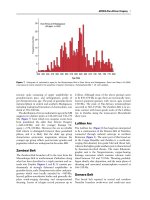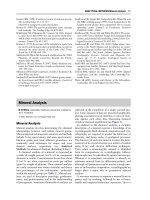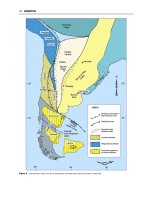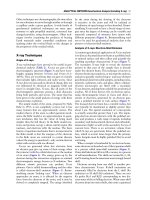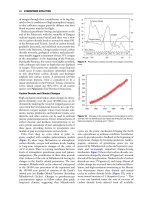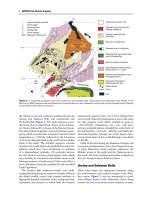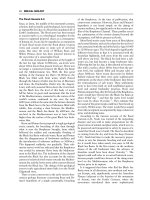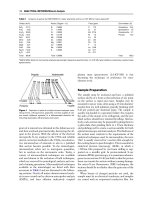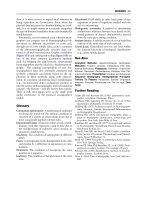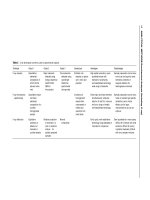Encyclopedia of geology, five volume set, volume 1 5 (encyclopedia of geology series) ( PDFDrive ) 1985
Bạn đang xem bản rút gọn của tài liệu. Xem và tải ngay bản đầy đủ của tài liệu tại đây (61.1 KB, 1 trang )
142 PALAEOECOLOGY
example, monoplacophorans, a primitive caplike molluscan class (see Fossil Invertebrates: Molluscs Overview), are known from a variety of shallow marine
sediments from the Lower Palaeozoic, apparently
living in communities alongside brachiopods and trilobites. They then apparently disappear from the
fossil record during the Devonian and were presumed
extinct until the celebrated rediscovery of Neopilina
during dredging of deep water (>3500 m) off the
coast of Mexico during the Danish-led Galathea expedition in 1952. However, it would clearly be inappropriate to reconstruct the palaeoecology of the
Palaeozoic forms based solely on our understanding
of the biology of Neopilina. Presumably during the
Upper Palaeozoic, monoplacophorans were forced,
perhaps by competition or predation pressure, into
deep-water refuges that are not represented in the
sedimentary record. Other Palaeozoic taxa that were
important and widespread in shelf communities, such
as brachiopods and stalked crinoids, are postulated
by some also to have been driven into refugia. These
examples clearly demonstrate the need to use several
lines of evidence when reconstructing palaeoecology
and, most importantly, not to divorce the study of
fossils from their lithological context.
What happens when there are no convenient living
homologues? In such cases, the palaeoecologists must
use more imaginative approaches. Trilobites (see
Fossil Invertebrates: Trilobites) became extinct by
the close of Palaeozoic, although much may be
gleaned of their palaeobiology by homology and by
analogy with other arthropod groups (such as understanding their moulting and likely internal anatomy).
It is believed that trilobites exploited a wide range of
life habits; although most were benthic, others were
pelagic or nektonic. Some (e.g., Calymene) are interpreted as having been voracious predators, whereas
others were thought to have been filter feeders or
deposit feeders. The lines of evidence used to elucidate
these different palaeoecological details are varied.
Much is reliant on detailed studies of functional
morphology, but evidence from trace fossils (including
some that show evidence of trilobites tracking worms)
and experimental modelling have also played a role.
An interesting example is the interpretation of the
Lower Palaeozoic olenellids as possible chemosymbionts in an elegant study by Richard Fortey. Using a
combination of evidence based on the functional
morphology of the family, principally the large
number and wide nature of the thoracic segments
and degenerate hypostome, the lithological evidence
that olenellids tended to inhabit sulphur-rich unbioturbated black shales, and by analogy with totally
unrelated modern chemosymbiotic organisms such as
lucinid bivalves, Fortey suggested that these trilobites
might well have harboured sulphate-reducing bacteria
on their gills, which allowed them to live in ‘difficult’
oxygen-poor environments.
When living relatives and even good analogues are
absent, more unconventional approaches can be taken
in the study of the fossil mode of life. Graptoloids
(see Fossil Invertebrates: Graptolites) were a significant group of macrozooplankton living in the Ordovician to mid-Devonian open seas. They have very
remote living relatives, the pterobranchs, but their
benthic, encrusting mode of life makes direct comparisons unrealistic. Instead, work has concentrated on
the response of graptoloid shapes to seawater, which
had the same properties in the Lower Palaeozoic as it
does now. Physical and computer-derived models
show that both the overall colony shape and its
detailed morphology would have had important consequences for the behaviour of the species in water.
Colonies were designed to rotate during movement,
thereby increasing the volume of water that could be
sampled. Flow of water was directed into the thecal
apertures where the zooids lived by an arrangement of
spines, hoods, or hooks in many species. A standard
orientation relative to the dominant direction of water
flow was maintained by structures such as the virgella
and virgula, arrayed at the proximal and distal ends of
the colony (Figure 2). Understanding the physical
effects of adaptations shown by fossils allows inferences about life habits to be made (for example, concerning the likely feeding position of the zooids and
the sampling requirements that conditioned their
fitness and hence evolution).
Palaeosynecology
Ecologists define a community as a recurring group of
taxa (in fixed proportions) that live together in a
particular habitat. The focus of interest is in the way
in which populations of single species or different taxa
interact and the manner in which resources within
that habitat are shared between the different groups.
Ecological studies can be well founded on quantitative
analyses based on direct observations. Palaeoecologists, however, are faced with a number of problems
and must use less direct methods. First, a high proportion of any community may be soft-bodied or weakly
skeletonized such that they are unlikely to be preserved in the fossil record. It is estimated that more
70% of modern taxa fall into this category and
the Middle Cambrian Burgess Shale lagerstaă tte (see
Lagerstaătten) provides a salutary lesson, showing the
wealth of poorly or unskeletonized organisms (such as
worms and arthropods) not usually preserved in contemporary deposits. Second, relatively few organisms
are preserved in life position and many may have been
